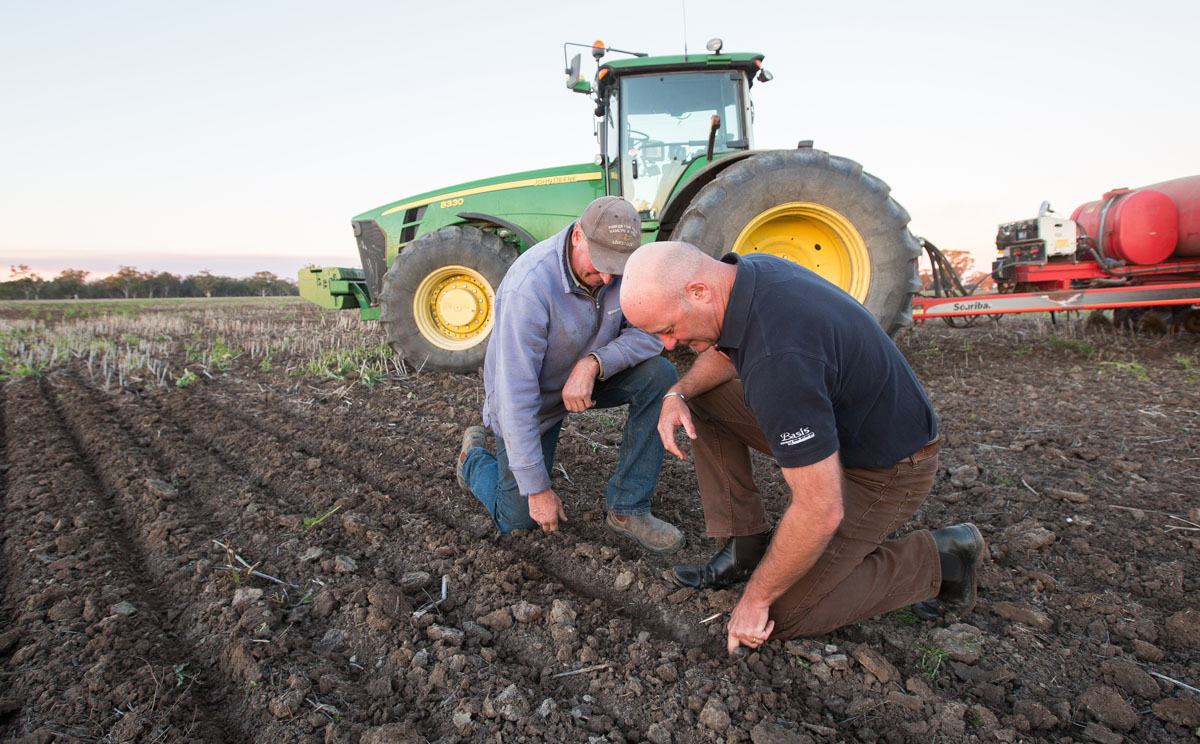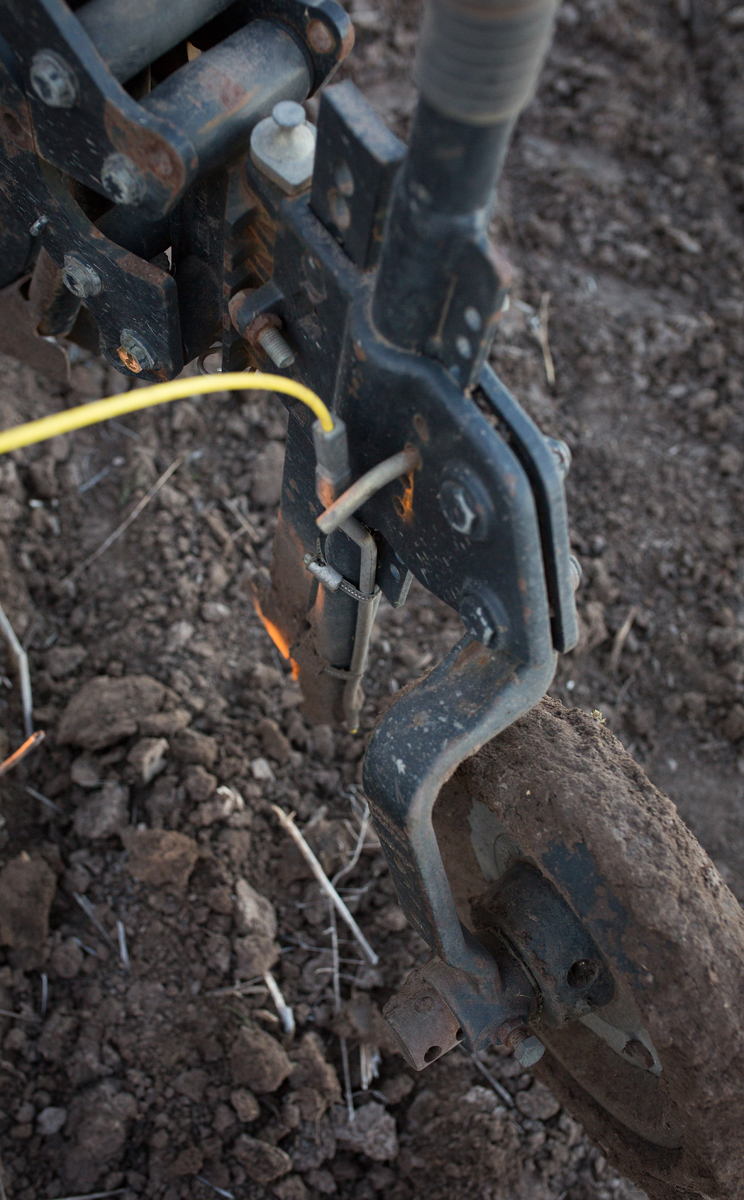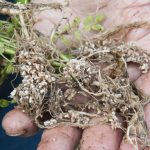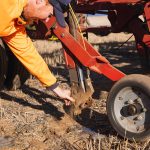Clay soils respond to fertiliser biocatalyst injected in-furrow
Strengthened root structure in barley and improved wheat yields have reinforced the Hannafords’ commitment to liquid injection in South Australia’s North East.
Injecting a liquid fertiliser biocatalyst in-furrow is helping South Australian cropping farmer Peter Hannaford unlock nutrients in his property’s heavy clay soils.
| ABOUT |
|---|
- WHO: Peter Hannaford
- WHERE: Frances, SA – 32km north east of Naracoorte, South Australia
- CROP: 1400ha of wheat, barley, beans and canola
- EQUIPMENT: Liquid Systems (SA) PR-1 Module and Stacker Distribution Kit with Terminal Assembly
| OUTCOMES |
|---|
- Increased root structure
- Barley plants with signs of better phosphorous uptake
- Approx 300 – 500kg/ha wheat yield increases in 2016
Guided by Landmark senior agronomist Craig Hole, Peter purchased a Liquid Systems (SA) PR-1 Module in 2015 to improve soil nutrition and structure.
“The basis of any good cropping program is how well your soil is performing,” said Craig, an agronomist for the past 30 years. “The challenge on Peter’s property is balancing soil structure and nutrition. Some of his soils are sodic, so when it’s wet they turn to slush and when it’s dry they set like concrete. “You have trouble making nutrients available to plants in those conditions.”
Using his Liquid Systems (SA) unit last season, Peter applied the Loveland liquid product, Foundation Liquid Manure (LM), a fertiliser biocatalyst that activates microbial activity in the soil, freeing nutrients for plant use.
“It helps speed up the breakdown process of any applied nutrients, by making the good microbes that are already in the soil far more active,” said Craig.
“That means background levels of essential nutrients – especially phosphorus that is not mobile and can get tied up easily – become available to the plant. In addition, it has a very positive effect on soil structure. For Peter, that means reducing soil sodicity.”
Craig says the impact from applying Foundation LM in-furrow was immediate, with a noticeable change to root structure in Peter’s barley crops.
“The first thing we noticed was a more strongly developed root system, with more secondary roots and root hairs,” said Craig. “The fine plant roots intercept more nutrition and moisture, so the more you can develop those, the more the crop can grow.
“Plus, waterlogging is common in the North East, so if you get a plant up and going more rapidly with a stronger root system, you’ve got more chance of getting it through a wet period.”
The stem colour of Peter’s barley plants was another interesting outcome. Barley that had received a liquid injection of Foundation LM had green stalks whereas those without it appeared purple in colour. “The purply stalks showed that those plants were struggling to take up phosphorus,” said Peter.
Although Peter says exact yield numbers from trials conducted on his farm last year are yet to be verified, it is clear there were wheat yield increases.
“It does look good. We’re waiting for the results to be analysed, but from what I saw in the header, there were increases of between 300 and 500 kilograms per hectare across my wheat crops,” said Peter. “Based on that, I’ll certainly inject liquids again this year.”
Applied at a low rate ranging between 2.5L/ha and 5L/ha, ensuring every seed in every row receives the same amount of liquid is critical for the success of the application. “Five litres of Foundation LM over 10,000 square metres is not a lot of product, so you want to make sure it’s applied accurately,” said Craig. “It’s crucial that it’s not going out at 10L/ha in some areas and none in others. You want an even 5L/ha and it needs to be a constant stream, so you know that every plant can access it. If it’s starting and stopping, then you’ve lost your advantage straight away.
“The accuracy of the Liquid Systems (SA) equipment, right across the bar, is second to none. The good thing with Peter Burgess’ systems is they are built to a standard. And because he’s a perfectionist, nothing goes out of his factory unless it’s accurate and it lasts.”
Consistency of application proved an early challenge for the Hannafords, due to their comparatively small seeder bar, at 9.75m wide. “In the beginning, we tried to put out a 25L/ha mix of water and Foundation LM but we couldn’t maintain the pressure across my small seeder bar at such a low rate. But Peter Burgess offered us a special pressure regulator that was able to maintain lower rates and that solved the problem. Our application of Foundation LM mixed in water now ranges from 30L/ha to 33L/ha and the system is holding that rate well.”
For the Hannafords, equipment reliability is also key at one of the most critical times in their farming program.
“You don’t want issues when you’re in the middle of seeding,” said Peter. “While the Liquid Systems (SA) equipment might not be cheap, it is a very well built machine with no issues. And that’s what Peter Burgess is all about. He doesn’t want a machine out there that’s going to create issues.”
Another adjustment the Hannafords made on their Liquid System (SA) unit was the distance between the end of the injection tubing and the end of the stainless steel protective pipes. Initially, the pipes and the tubing were level with one another, but they found this set-up was prone to blockages, so adjusted the tubes to sit 3mm to 5mm below the pipes. “The tubes now flicker, which prevents any blockages. Peter didn’t get a blockage at all last year,” said Craig.
This year, the Hannafords plan to inject trace elements and a fungicide in-furrow, including copper, zinc and Flutriafol, which will be added to their 30L/ha mix of water and Foundation LM. Last year they applied granular fertiliser coated with trace elements. “Some of the soils on the Hannaford’s property are quite trace element deficient – especially from a copper perspective,” said Craig. “We hope to maximise their availability by applying them as a liquid at seeding. The issue with coated granular applications of trace elements is that they are not continuously available. By nature, granular fertilisers are interspersed along the plant line, so it is often only pure luck that plant roots access an adequate amount of product. An injected liquid product is readily available to the growing plant in a continuous stream. Perfect.”
Get a Quote
"*" indicates required fields











